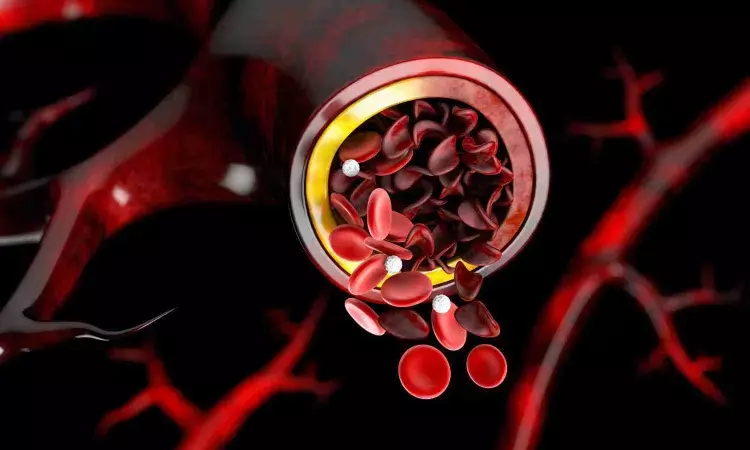- Home
- Medical news & Guidelines
- Anesthesiology
- Cardiology and CTVS
- Critical Care
- Dentistry
- Dermatology
- Diabetes and Endocrinology
- ENT
- Gastroenterology
- Medicine
- Nephrology
- Neurology
- Obstretics-Gynaecology
- Oncology
- Ophthalmology
- Orthopaedics
- Pediatrics-Neonatology
- Psychiatry
- Pulmonology
- Radiology
- Surgery
- Urology
- Laboratory Medicine
- Diet
- Nursing
- Paramedical
- Physiotherapy
- Health news
- Fact Check
- Bone Health Fact Check
- Brain Health Fact Check
- Cancer Related Fact Check
- Child Care Fact Check
- Dental and oral health fact check
- Diabetes and metabolic health fact check
- Diet and Nutrition Fact Check
- Eye and ENT Care Fact Check
- Fitness fact check
- Gut health fact check
- Heart health fact check
- Kidney health fact check
- Medical education fact check
- Men's health fact check
- Respiratory fact check
- Skin and hair care fact check
- Vaccine and Immunization fact check
- Women's health fact check
- AYUSH
- State News
- Andaman and Nicobar Islands
- Andhra Pradesh
- Arunachal Pradesh
- Assam
- Bihar
- Chandigarh
- Chattisgarh
- Dadra and Nagar Haveli
- Daman and Diu
- Delhi
- Goa
- Gujarat
- Haryana
- Himachal Pradesh
- Jammu & Kashmir
- Jharkhand
- Karnataka
- Kerala
- Ladakh
- Lakshadweep
- Madhya Pradesh
- Maharashtra
- Manipur
- Meghalaya
- Mizoram
- Nagaland
- Odisha
- Puducherry
- Punjab
- Rajasthan
- Sikkim
- Tamil Nadu
- Telangana
- Tripura
- Uttar Pradesh
- Uttrakhand
- West Bengal
- Medical Education
- Industry
Hydroxyurea dose escalation enhances clinical outcomes in children with sickle cell anemia: Study

The Realizing Effectiveness Across Continents with Hydroxyurea (REACH) trial unveiled promising results in the treatment of sickle cell anemia among children in sub-Saharan Africa. The findings of this study was published in a recent issue of The Lancet Haematology which highlights the effectiveness of the extended hydroxyurea treatment over a period of 8 years.
This research was conducted across 4 clinical sites in Kenya, Uganda, Angola and the Democratic Republic of Congo by enrolling a total of 635 children aged 1 to 10 years with documented sickle cell anemia. Over the course of the study, 606 children received hydroxyurea treatment, with 522 continued treatment for a median duration of 93 months.
The key findings of this study revealed a significant improvement in the treatment outcomes. The children who received hydroxyurea expressed an increased mean hemoglobin concentration and fetal hemoglobin level along with a reduction in the absolute neutrophil count. The dose escalation to the maximum tolerated dose (MTD) with dose optimization led to a marked reduction in vaso-occlusive episodes, acute chest syndrome events, recurrent stroke events, malaria infections, non-malarial infections, serious adverse events and mortality rates when compared to fixed-dose hydroxyurea.
Incidence rate ratios indicated a substantial decrease in various adverse events that included vaso-occlusive episodes, acute chest syndrome events, and malaria infections, among others. The dose-limiting toxicity rates remained similar between the fixed-dose and MTD phases by suggesting the safety and feasibility of the treatment approach. Also, grade 3 and 4 adverse events were infrequent, with serious adverse events uncommon and no treatment-related deaths were reported. This signifies a significant move in enhancing the quality of life and prognosis for the children battling sickle cell anemia in the region.
As sickle cell anemia poses a significant health burden in sub-Saharan Africa where resources for comprehensive care are often limited, the outcomes of this study were profound. The REACH trial offers hope for the population affected by this hereditary blood disorder by demonstrating the effectiveness and safety of extended hydroxyurea treatment. Overall, this comprehensive trial illuminates the importance of tailored treatment strategies for sickle cell anemia in resource-limited settings.
Source:
Aygun, B., Lane, A., Smart, L. R., Santos, B., Tshilolo, L., Williams, T. N., Olupot-Olupot, P., Stuber, S. E., Tomlinson, G., Latham, T., & Ware, R. E. (2024). Hydroxyurea dose optimisation for children with sickle cell anaemia in sub-Saharan Africa (REACH): extended follow-up of a multicentre, open-label, phase 1/2 trial. In The Lancet Haematology. Elsevier BV. https://doi.org/10.1016/s2352-3026(24)00078-4
Neuroscience Masters graduate
Jacinthlyn Sylvia, a Neuroscience Master's graduate from Chennai has worked extensively in deciphering the neurobiology of cognition and motor control in aging. She also has spread-out exposure to Neurosurgery from her Bachelor’s. She is currently involved in active Neuro-Oncology research. She is an upcoming neuroscientist with a fiery passion for writing. Her news cover at Medical Dialogues feature recent discoveries and updates from the healthcare and biomedical research fields. She can be reached at editorial@medicaldialogues.in
Dr Kamal Kant Kohli-MBBS, DTCD- a chest specialist with more than 30 years of practice and a flair for writing clinical articles, Dr Kamal Kant Kohli joined Medical Dialogues as a Chief Editor of Medical News. Besides writing articles, as an editor, he proofreads and verifies all the medical content published on Medical Dialogues including those coming from journals, studies,medical conferences,guidelines etc. Email: drkohli@medicaldialogues.in. Contact no. 011-43720751


